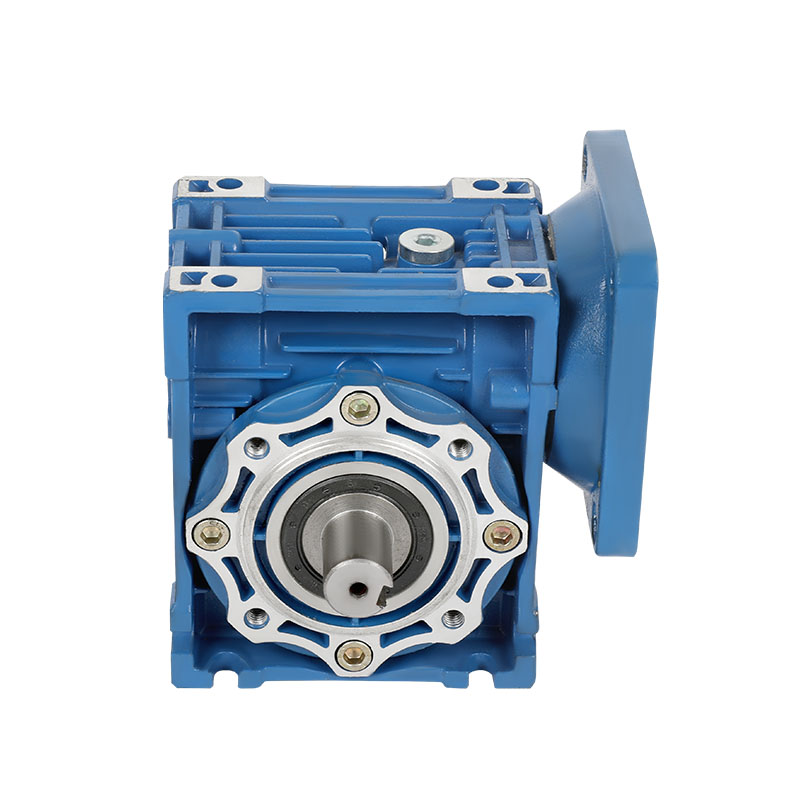Thermal expansion has a significant impact on the assembly accuracy and operating performance of the RV Worm Gear Reducer, and this impact is mainly reflected in the following aspects:
Influence on assembly accuracy
Clearance change:
Thermal expansion causes the meshing clearance between the worm and the worm wheel to change. If the thermal expansion effect is not considered during the initial assembly, the following problems may occur:
Too tight meshing: Material expansion at high temperatures may cause the meshing clearance to decrease, increasing friction and wear.
Too loose meshing: If the clearance reserved in the design is too large, insufficient meshing may occur under low temperature conditions, reducing transmission efficiency.
Axial and radial displacement:
Thermal expansion may cause axial or radial displacement of bearings, gear shafts and other key components, thereby destroying the original assembly accuracy. For example:
Thermal expansion of the worm shaft may cause its axial movement, which in turn affects the contact area distribution of the worm wheel.
The deformation of the bearing seat due to thermal expansion may change the preload of the bearing and affect the rotation accuracy.
Symmetry destruction:
In complex structures, the difference in thermal expansion coefficients of different materials may cause the symmetry of the overall structure to be destroyed, further affecting the assembly accuracy.
Impact on running performance
Decrease in transmission efficiency:

Changes in meshing clearance caused by thermal expansion will directly affect transmission efficiency. Too tight meshing will increase friction loss, while too loose meshing may lead to increased sliding friction, both of which will reduce transmission efficiency.
Lubrication failure:
Increase in temperature will lead to a decrease in lubricant viscosity, a thinner oil film thickness, and even dry friction. In addition, thermal expansion may change the geometry of the lubrication channel, affecting the distribution and circulation of the lubricant.
Increase in vibration and noise:
Misalignment or poor meshing caused by thermal expansion will lead to increased vibration and noise, especially under high-speed operating conditions. This not only affects the stability of the equipment, but may also accelerate fatigue damage to components.
Shortened fatigue life:
Long-term high-temperature operation will cause creep and fatigue of the material, especially under high-load conditions. Stress concentration caused by thermal expansion will further shorten the service life of the worm reducer.
Decrease in sealing performance:
Thermal expansion may cause deformation of seals (such as O-rings or lip seals), thereby reducing the sealing effect. Leakage problems will not only affect the lubrication system, but may also pollute the environment or damage other components.
Solutions and Countermeasures
In order to reduce the impact of thermal expansion on the assembly accuracy and operating performance of RV Worm Gear Reducer, the following measures can be taken:
Design Optimization
Reserve thermal expansion compensation gap:
During the design stage, according to the operating temperature range and the thermal expansion coefficient of the material, reasonably reserve the meshing gap and axial clearance to adapt to the change of thermal expansion.
Select matching materials:
Try to use materials with similar thermal expansion coefficients to manufacture worms and worm wheels to reduce structural deformation caused by material differences.
Improve structural design:
Adjustable bearing seats or elastic couplings are used to allow certain thermal expansion deformation without affecting the overall performance.
Manufacturing and assembly process
Precisely control assembly dimensions:
Strictly control the initial dimensions and tolerances of each component during the assembly process to ensure good fit even under thermal expansion conditions.
Use high-temperature materials:
For high-temperature working conditions, select high-temperature resistant materials or coatings to improve the thermal stability of components.
Lubrication and cooling
Optimize the lubrication system:
Use lubricating oil with excellent high-temperature performance and ensure uniform distribution of lubricating oil through a forced lubrication system.
Enhance heat dissipation capacity:
Add heat sinks, fans or water cooling devices to reduce the operating temperature of the reducer and slow down the thermal expansion effect.
Monitoring and maintenance
Real-time temperature monitoring:
Install temperature sensors to monitor the operating temperature of the reducer in real time and detect abnormal conditions in time.
Regular maintenance:
Regularly check the meshing clearance, bearing preload and sealing performance, and adjust or replace parts when necessary.
Thermal expansion has a significant impact on the assembly accuracy and operating performance of the RV Worm Gear Reducer, including changes in meshing clearance, decreased transmission efficiency, lubrication failure, increased vibration and noise, and shortened fatigue life. Through reasonable design optimization, manufacturing process improvement, improvement of lubrication and cooling systems, and regular maintenance, these effects can be effectively alleviated to ensure the stable operation and efficient performance of the worm reducer under various working conditions.

 English
English русский
русский bahasa Indonesia
bahasa Indonesia
